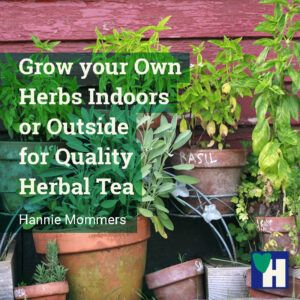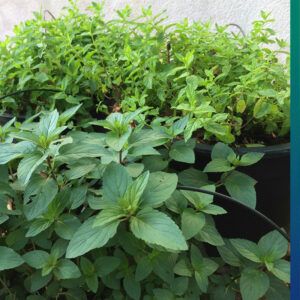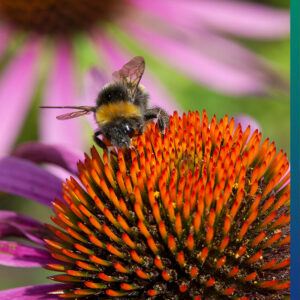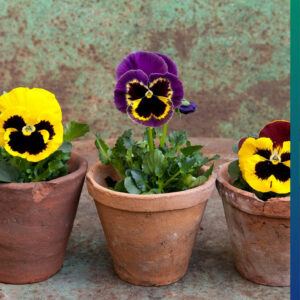
As you may know, Tom and I are huge advocates of organic food. Yet we are also aware that in some places organic produce is hardly available. So why not grow some yourself? And if you don’t have a garden, herbs are especially easy to grow indoors.
Some are easy growers, others need more attention. The orientation of your window is important, as well as the soil you put them in. You can sow them or use cuttings. And nowadays there are complete, highly sophisticated indoor systems.
Personally, I like the simple way, but we are all different. So if you want to grow your own herbs indoors, choose the method that suits you best. You’ll be all the more motivated once results are coming.
Some of the links are affiliate links. As an affiliate associate, we earn a commission when you purchase any of the products offered through the shared links at no extra cost for you. This helps us maintain this website.
Table of contents
Grow your own herbs indoors
By growing your own herbs indoors you’ll always have a wide choice for your healthy herbal tea. It’s quite simple to grow herbs in pots. You will have a guaranteed organic and pest-free quality that way.
Indoors or outdoors?

A part of our garden is turned into a kitchen garden. When we were still living in the Netherlands we had one season which lasted from May until October. Over here in Spain, we have at least 2 seasons and some vegetables like carrots we can even grow 3 times a year.
So the possibilities of the number of harvests and the crop you can plant depend highly on where you are located. Growing inside is almost possible anywhere, although you will need extra lights if you live in a place with little daytime in winter. I used to have a couple of pendant lamps with special blue light.
The advantage of growing herbs indoors is that they won’t be eaten by insects. Apart from all the advantages we have over here, we also have a lot of grasshoppers in the garden. Very photogenic creatures, but at times a pain in the you-know-what. 🙂
Related: Grow your own Fruits and Vegetables Sustainably and Tasty
Benefits of drinking herbal tea
Herbal teas contain many antioxidants and vitamins that are beneficial for the body and mind.

Some of the best herbal teas that boost the immune system are echinacea, ginger, elderberry, and licorice root tea.
Herbal teas are delicious and refreshing. They also promote good health, and some are used to combat various ailments. Growing your own herbs allows you to have everything you need at hand any time you want a good cup of tea. You can also buy the herbs, roots, and flowers you need to make various types of herbal tea at health food stores.
Most of the herbs used to make tea are easy to grow. You can plant many of them in containers if planting them in the ground isn’t an option. Indoors, on a balcony or terrace, any place with sunlight.
In this article, I describe some good herbs to use for making tea, along with some things to keep in mind when growing them.
Related: Red Food and the Health Benefits of Antioxidants
Is it bad to drink herbal tea every day?

Even water in enormous quantities is bad for our health. So if you overdo it also herbal tea can cause problems. Most reported are headaches, digestive problems, distress, and sleeping problems.
Overdoing it means you drink more than 1 liter of herbal tea daily. As I often write on this website: we are not all the same. So if you drink more than 4 cups and don’t experience any problems, you’ll be fine.
A test is to occasionally drink a lot more or a lot less than you’re used to. If your body is reacting fiercely to that change of regime, then you should alter your intake. But I am not a doctor or dietitian, so consult an expert in case you’ve any doubts.
Related: What is the Best Time for Supplements, Water, and Food?
Types of herbal teas
This list of herbal teas is not complete, but I have chosen the ones that are a breeze to grow indoors. Licorice is great, yet a bit more difficult than mint. Especially if this is going to be your first try to grow your own herbs indoors I recommend starting with the easier ones.
Mint
There are many different types of mint, and most of them make a wonderful tea. Peppermint is one of the most popular. If you have more adventurous tastes, try pineapple mint or orange mint. I have peppermint and a milder kind of mint I like to combine because pure peppermint is a bit too sharp for my taste.

Mints are generally hardy plants, and they will spread like crazy if allowed to do so. Even in the garden they are best grown in pots and containers or planted in the ground in the middle of tall, bottomless containers. Tea is made from the leaves or small twigs.
Echinacea
This tea is a favorite of mine. I used to drink it to prevent colds and flu every winter. In Spain, it is not a very common plant, so I haven’t found one yet to grow myself. That’s a pity because – off-topic – they are also great to take photographs of. They are very attractive to bees.
The leaves are used for tea. In Echinacea teas you buy in a shop often fennel, ginger, or cardamom is mixed for optimal effect.
Lemon balm
Closely related to mint, lemon balm also makes a tasty tea. It has a minty lemon flavor. Lemon balm grows best in dry soil and partial shade. The leaves are used to make tea.
Chamomile
Chamomile tea is very soothing, and it is also used to treat a variety of health problems like digestive issues and cramps. It is very easy to grow. Chamomile grows best in sunny, moist areas. The flowers are used for making tea.
In Spain, it’s very common to order a Manzanilla. It’s probably as common as Earl Grey is in the UK? Where in the Netherlands most cafes will be able to serve fresh mint tea, but Chamomile is much harder to order.
Lavender
If you’re looking for a tea to help you unwind after a stressful day, lavender tea is a great choice. Lavender is well-known for its calming effect, and it can help relieve tension headaches. It needs full sun and well-drained soil to flourish. Use the buds for tea making.
Coriander

Also known as cilantro, this herb is most often used in cooking, but it makes a nice tea as well. It has a unique spicy, citrusy flavor. Coriander grows in full sun or partial shade. The leaves are used to make tea.
Violet
Violet tea is quite refreshing, and it’s also a great source of vitamins A and C. Violets grow best in shady areas. Tea is made from the dried leaves and flowers of the plant.
Thyme
Another herb that is usually used for cooking, thyme has a spicy flavor. Thyme tea is most often used for medicinal purposes, as it is good for sore throat and stomach problems. Thyme grows best in full sun or partial shade. Leaves and flowers may be used to make tea.
Herbs for detox tea

Some herbs are perfect for detoxification. For example, cardamom, nettle (also a perfect iron supplier), cinnamon, spearmint, cloves, ginger, lime blossom, licorice, parsley, and turmeric. Not all of those will be easy to grow indoors, but once you get the hang of growing stuff yourself it’s worth a try.
A detox occasionally does wonders for your body and mind.
- Increases energy and mental alertness;
- Cleanses the liver;
- Promotes healthy skin;
- Reduces Inflammation;
- Supports digestion.
Related: How to Lose Weight without Hunger in a Practical Way
Start your own herbal garden indoors
Almost anyone can grow a herbal tea garden. Many of these herbs mentioned do well indoors in containers as long as they get adequate sunlight. You don’t need a lot of space to produce enough herbs to make tea any time you like.
And the nicest additional benefit is that it is so relaxing to take care of your plants and to see them grow.
Did you ever grow herbs in pots? If you can add any tip here, put it in the comment box below. We will highly appreciate it.


Growing our own plants has many benefits, as you have mentioned. It’s always great to see our plants and animals growing and being a part of our lives. Having and nurturing both really grounds and gives us a much-needed connection to the natural world.
My wise mum always told us kids that anything in moderation is ok. I think she was normally referring to chocolates and cakes, however, I think the same could be said of herbal teas.
Herbs can be used as a form of medicine, and our bodies need a balanced amount of many different ingredients to function optimally. With this in mind, I’ve always had a selection of at least 4 or five to choose from at any given time, and ‘I let my body tell me which one it wants’ at any given time.
I’m going to come back and watch the embedded video when I have time later….. I love plants, and the reality is that once we consume them, they become part of our make-up….. We cannot survive without them!
Many thanks for sharing 🙂
Hey Andrew, yes, your mum was a wise woman. Still, I would like to alter it a little bit: ‘most in moderation is ok’. There are things we can’t have enough of, like sunshine and love, warmth and kindness. But I am sure your mother would agree, and that she was only talking of what we put in our mouth. 🙂
I used to buy herbal tea. The teabagged kind. And then I would be annoyed that those bags could not be thrown on the compost heap. Because of the plastic that is in the glue and of course, I don’t want plastic in the compost heap. The organic shop in my village only had tea in plastic bags until a little while ago. Now they have a couple of mixes in paper bags. Phew.
And I have discovered that the organic shop in a coastal village we go to once in a while has a lot of different teas in glass jars, from which we can choose the amount we like. Marvelous! The perfect solution for times when the herbs in our garden and on the windowsill are too small.
What a nice image you painted: plants become part of our make-up. You are so right. Thanks.
Wow! What a great video.
Danielle sure is passionate about her food and her health and well-being.
The solutions she provides to a bad diet are simple, common sense, and easy to implement.
It all comes down to choice… do we want to improve or maintain our own health naturally by taking responsibility for our diets, or do we let the manufacturers of processed goods sway us with their ‘awesome’ ads telling us how ‘good’ their foods are.
I for one am going to add more of what she suggests, more often, into my diet. More sprouts, more sauerkraut, and more seaweed. And the great thing is that I can grow the sprouts and make the sauerkraut in my own kitchen!
Many thanks for sharing 🙂
Yes, it’s marvelous, isn’t it. It keeps amazing me, that no matter how simple solutions can be, there are still people that make the wrong choices. Even saying “I should…” and nevertheless not able or not willing to change. And we can’t force people. Everyone has a right to make his or her own choices. All we can do – and do – is living the way we think is right and hoping our example gets followed. 🙂
Thanks for your uplifting comments, Andrew.
I live in Dubrovnik, Croatia. We have plenty of sunny days, and the temperature almost never goes under 0. I’d like to grow lemon inside my house. It’s full of vitamin C, and I just like to drink lemonade, or add it to some salads, etc.
However, I’ve heard that it’s a very sensitive plant and requires a lot of attention. Do you have any advice for me? How would you grow it inside your apartment?
Lucky you, Petar, with that kind of climate. Lovely!
Coincidentally I read an article yesterday about the new cities that are built in China. They are full of concrete. And the builders thought it was a good idea to plant trees in between the high buildings. Because of the size of the buildings, they decided that replanting old trees from the countryside would be the best solution because the young, little trees wouldn’t stand out enough.
Trees are sensible, however. Their roots are often much wider spread than the crown. To move them requires cutting the roots and the branches. Most trees don’t survive such harsh treatment. All of them need support when they are planted to be able to stand straight and the older they are, the less chance of survival.
So it’s hard to grow them inside the house. You would need a really big container. It’s doable yet I would advise against it because of all the space it would take. Still, if you do plant a tree inside the house, don’t forget to ‘be a bee’ whenever there is blossom!
It’s what I do at the moment with the paprika plant that accidentally grows in my pot of mint. With a soft-haired paintbrush, I gently sweep over the stamens of the different flowers so that a bell pepper will grow.